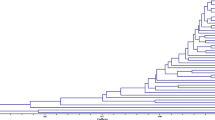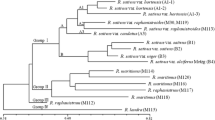Abstract
RAPD markers were used to evaluate genetic similarity among 35 mandarin accessions, including 10 species and 7 hybrids. One octamer and twenty-two decamer primers produced 109 RAPDs, 45 of which were polymorphic. Jaccard coefficient was used to calculate genetic similarity, and UPGMA to generate the phenogram. The RAPDs obtained were sufficient to generate some accession-specific markers, and to separate these accessions by clustering them into several groups, many of them according to Tanaka's or Webber's systematic units. The genetic similarity within the mandarin group is high (GJ = 0.77), and suggests that cultivated mandarins have a narrow genetic base. The genetic similarity of mandarins to other true citrus species (Citron [C. medica L.] and Pummelo [C. grandis Osbeck]) was much lower (minimum GJ = 0.27). We propose that the mandarin group is a single species, C. reticulata Blanco, composed of several genetically different individuals and a great number of hybrids, rather than a large number of species as proposed by some taxonomic studies.
Similar content being viewed by others
References
Ashari, S., D. Aspinall & M. Sedgley, 1989. Identification and investigation of relationships of mandarin types using isozyme analysis. Sci Hort 40: 305-315.
Barret, H.C. & A.M. Rhodes, 1976. A numerical taxonomic study of affinity relationships in cultivated Citrusand its close relatives. Syst Botany 1: 105-136.
Cameron, S.W. & H.B. Frost, 1968. Genetics, breeding, and nucellar embryony. In: W. Reuther, L.D. Batchelor & H.D. Weeber (Eds), The Citrus Industry, pp. 325-389, vol. 2. University of California, USA.
Caetano-Anollés, G., B.J. Bassam & P.M. Gresshoff, 1991. DNA amplification fingerprint using very short arbitrary ologonucleotide primers. Biotechnology 9: 553-556.
Davies, F.S. & L.G. Albrigo, 1994. Taxonomy cultivars and breeding. In: F.S. Davis & L.G. Albrigo (Eds), Citrus, pp. 12-52. Wallingford, CAB International.
Grattapaglia, D. & R. Sederoff, 1994. Genetic linkage maps of Eucalyptus grandisand Eucalyptus urophyllausing a pseudotestcross: Mapping strategy and RAPD markers. Genetics 137: 1121-1137.
Green, R.M., A. Vardi & E. Galun, 1986. The plastome of Citrus. Physical map, variation among Citruscultivars and species and comparison with related genera. Theor Appl Genet 72: 170-177.
Guerra, M.S., 1984. Cytogenetics of Rutaceae. II. Nuclear DNA content. Caryologia 37 (3): 219-226.
Handa, T., Y. Ishizawa & C. Oogaki, 1986. Phylogenetic study of Fraction I protein in the genus Citrusand its close related genera. Jpn J Genet 61: 15-24.
Hodgson, R.W., 1967. Horticultural varieties of citrus. In: W. Reuther, H.J. Webber & L.D. Batchelor (Eds). The Citrus Industry, pp. 431-591, vol. 1. University of California, USA.
Luro, F., F. Laigret & J.M. Bove, 1992. Application of random amplified polymorphic DNA(RAPD) to Citrusgenetics and taxonomy. Proc Int Soc Citriculture: 225-228.
Luro, F., F. Laigret, J.M. Bove & P. Ollitraut, 1995. DNA amplified fingerprinting, a useful tool for determination of genetic origin and diversity analysis in Citrus. HortScience 30 (5): 1063-1067.
Machado, M.A., H.D. Coletta Filho, M.L.P.N. Targon & J. Pompeu Jr., 1996. Genetic relationship of Mediterranean mandarins (Citrus deliciosaTenore) using RAPD markers. Euphytica 92: 321-326.
Matsuyama, T., R. Motohashi, T. Akihama & M. Omura, 1992. DNA fingerprinting in Citruscultivars. Jpn J Breed 42: 155-159.
Motohashi, T., T. Matsuyama & T. Akihama, 1992. DNA fingerprinting in Citruscultivars. Proc Int Soc Citriculture: 221-224.
Murray, M.G. & W.F. Thompson, 1980. Rapid isolation of high molecular weight plant DNA. Nucl Acids Res 8: 4321-4325.
Paran, I., R. Kesseli & R. Michelmore, 1991. Identification of RFLP and RAPD markers linked to downy mildew resistance genes in lettuce using near-isogenic lines. Genome 34: 1021-1027.
Rohlf, F.J., 1992. NTSYS-pc Numerical taxonomy and multivariate analyses system (version 1.7). State University of New York, NY.
Roose, M.L., 1988. Isozymes and DNA restriction fragment length polymorphisms in citrus breeding and systematics. Proc Int Soc Citriculture: 155-165.
Sambrook, J., E.F. Fritsch & T. Maniatis, 1989. Molecular cloning: a laboratory manual. Cold Spring Harbor Laboratory Press, Cold Spring Harbor, New York.
Scora, R.W., 1975. On the history and origin of citrus. Bull Torrey Bot Club 102 (6): 369-375.
Swingle, W.T., 1943. The botany of citrus and its wild relatives of the orange subfamily. In: H.J. Webber & L.D. Batchelor (Eds), The Citrus Industry, pp. 129-474, vol. 1 (first edition). University of California, USA.
Swingle, W.T., 1967. The botany of citrus and its wild relatives. In: W. Reuther, H.J. Webber & L.D. Batchelor (Eds), The Citrus Industry, pp. 190-430. vol. 1 (second edition). University of California, USA.
Tanaka, T., 1954. Species problems in citrus. Japanese Society for the Promotion of Science, Ueno, Tokyo, 152 pp.
Torres, A.M., R.K. Soost & U. Ziedenhofen, 1978. Leaf isozymes as genetic markers in Citrus. Amer J Bot 65 (8): 869-881.
Webber, H.J., 1943. Cultivated varieties of Citrus. In: H.J. Webber & L.D. Batchelor (Eds), The Citrus Industry, pp. 475-642, vol. 1. University of California, USA.
Author information
Authors and Affiliations
Rights and permissions
About this article
Cite this article
Coletta Filho, H., Machado, M., Targon, M. et al. Analysis of the genetic diversity among mandarins (Citrus spp.) using RAPD markers. Euphytica 102, 133–139 (1998). https://doi.org/10.1023/A:1018300900275
Issue Date:
DOI: https://doi.org/10.1023/A:1018300900275




